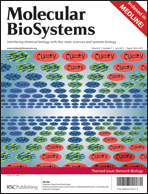This paper describes the synthesis of a novel 8-aza-7-deazapurin-2,6-diamine (DPP)-containing peptide nucleic acid (PNA) monomer and Boc protecting group-based oligomerization of PNA, replacing adenine (A) with DPP monomers in the PNA strand. The PNA oligomers were synthesized against the biologically relevant SV40 promoter region (2494-AATTTTTTTTATTTA-2508) of pEGFP-N3 plasmid. The DPP-PNA·DNA duplex showed enhanced stability as compared to normal duplex (A-PNA·DNA). The electronic distribution of DPP monomer suggested that DPP had better electron donor properties over 2,6-diamino purine. UV melting and thermodynamic analysis revealed that the PNA oligomer containing a diaminopyrazolo(3,4-d)pyrimidine moiety (DPP) stabilized the PNA·DNA hybrids compared to A-PNA·DNA. DPP-PNA·DNA duplex showed higher water activity (Δnw = 38.5) in comparison to A-PNA·DNA duplex (Δnw = 14.5). The 50 ns molecular dynamics simulations of PNA·DNA duplex containing DPP or unmodified nucleobase-A showed average H-bond distances in the DPP–dT base pair of 2.90 Å (O⋯H–N bond) and 2.91 Å (N⋯H–N bond), which were comparably shorter than in the A–dT base pair, in which the average distances were 3.18 Å (O⋯H–N bond) and 2.97 Å (N⋯H–N bond), and there was one additional H-bond in the DPP–dT base pair of around 2.98 Å (O2⋯H–N2 bond), supporting the higher stability of DPP-PNA·DNA. The analysis of molecular dynamics simulation data showed that the system binding free energy increased at a rate of approximately −4.5 kcal mol−1 per DPP base of the PNA·DNA duplex. In summary, increased thermal stability, stronger hydrogen bonding and more stable conformation in the DPP-PNA·DNA duplex make it a better candidate as antisense/antigene therapeutic agents.

You have access to this article
 Please wait while we load your content...
Something went wrong. Try again?
Please wait while we load your content...
Something went wrong. Try again?


 Please wait while we load your content...
Please wait while we load your content...